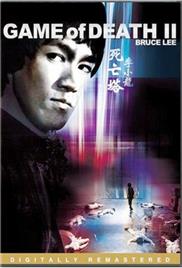Be Careful of Fake Websites. Always use HindiMovies.to domain & Join our Telegram Channel for Latest Updates.

Likes: 30
Views: 5.63K
While investigating his friend Chin Ku’s (Hwang Jang Lee) death, martial artist Billy Lo (Bruce Lee) is killed. His younger brother, Bobby Lo (Kim Tai Chung), investigates both deaths. His search takes him to Japan, where he befriends Lewis (Roy Horan), master of the Castle Of Death. But when Lewis is brutally murdered, Bobby must investigate the mysterious Fan Yu temple, where he must enter an underground pagoda and face off with the most terrifying of enemies.
Duration: 86 min
Released: 1981
IMDb Rating: 5.2/10 (2,398 Votes)
Genre: Action, Dubbed Movies, Mystery
Stars: Jang Lee Hwang, Bruce Lee, Tae-jeong Kim, Roy Horan
Directors: Corey Yuen, Sammo KamBo Hung, SeeYuen Ng
Writers: Chuo-lun Ting, Tin Shing Hoh
Year: 1981
Also Known As: Si wang ta
Server 1 – Estream
Server 2 – Vidto
Server 3 – Vidzi
Server 4 – Watchers
Faces of Death II is a 1981 documentary-style horror film that stands out as a sequel to the infamous original Faces of Death. This movie carries forward the same controversial and shocking approach of blending real and staged footage, designed to blur the lines between reality and fiction in a way that deeply unsettled audiences upon its release.
The film is helmed by Director John Alan Schwartz, who is also credited as the writer. Schwartz crafted this sequel with a careful intention to delve deeper into morbid and taboo subjects, underlining the darker curiosities of human nature. The film was produced by Michael Carr and James Brady, who also contributed to the original film’s notoriety. Their collaboration helped package the film in a way that ensured it appealed to fans of the cult classic original, while also expanding on the themes and graphic content.
The narrative structure of Faces of Death II is non-traditional and far from a conventional storyline found in typical action or mystery films. Instead, it is presented in a documentary format, where the film takes viewers through various scenes of death and morbidity, mixing real footage with reenacted sequences. The intention is to examine humanity's fascination with death and destruction from a pseudo-scientific perspective. This thematic exploration places it under genres such as action due to some staged violent sequences, mystery as it attempts to delve into the unknown aspects of death, and obviously the documentary and horror genres.
The film does not focus on characters or a cast in the traditional sense. Rather, it features various reenactments and actual footage, often narrated to provide context. Because of its controversial nature, the movie does not highlight well-known actors but instead relies heavily on the shock value of the visuals presented. This approach lends a chilling, voyeuristic aspect to the film, capturing the viewer's interest by pushing the boundaries of what is traditionally acceptable in cinema.
It is important to stress the impact Faces of Death II had upon its release. Its graphic content stirred significant debate about ethics in filmmaking, documentary authenticity, and censorship. At the time, it was among the most talked-about and often banned pieces of cinema worldwide, largely because of its graphic nature and its blend of real and staged footage which confused many viewers as to what was actual footage and what was simulated.
The film builds on the original by offering more elaborate and extensively staged scenes designed to shock and horrify. Some sequences depict bizarre and fatal accidents, experiments on death, and other provocatively simulated events aimed at confronting the audience with the topic of mortality head-on. While critics often condemned the movie for its explicit content and lack of clear disclaimers regarding the authenticity of the footage, it nevertheless amassed a cult following who appreciated the film's unique style and raw intensity.
In conclusion, Faces of Death II is more than just a horror film or an action mystery — it is an exploration of the macabre that has earned a notorious reputation over decades. It is a controversial artifact that reflects a period in cinema history where audiences sought the extreme, and filmmakers pushed limits to deliver unprecedented shock value. While it is not suitable for all viewers and remains heavily criticized, it undeniably holds a place in cult film history due to its impact and enduring fascination.